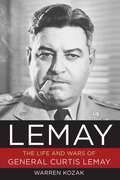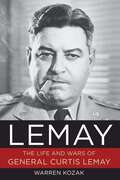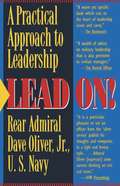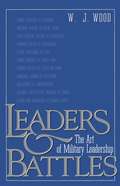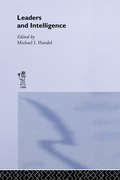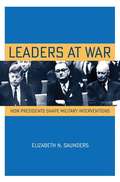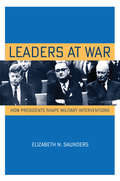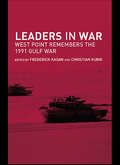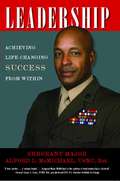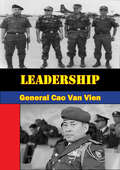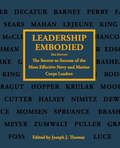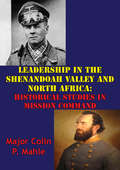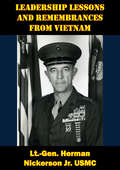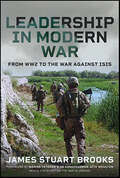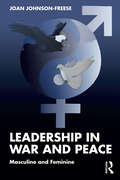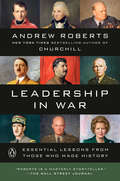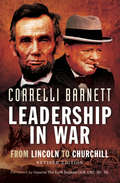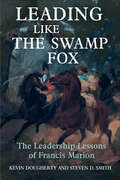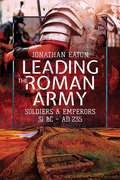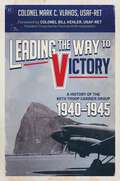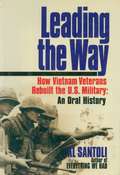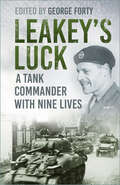- Table View
- List View
LeMay: The Life and Wars of General Curtis LeMay
by Warren KozakKozak’s biography of U.S. Air Force General Curtis E. LeMay (1906–1990) won’t convert those utterly convinced that he was a bomb-happy maniac. The more open-minded, however, will find in it a broader perspective on this controversial officer than we have had elsewhere. His outstanding competence as leader and organizer of strategic airpower in World War II and during the cold war is convincingly presented; so are his limitations in the Pentagon and his poor judgment in being George Wallace’s running mate in 1968.
LeMay: The Life and Wars of General Curtis LeMay
by Warren KozakKozak's biography of U.S. Air Force General Curtis E. LeMay (1906-1990) won't convert those utterly convinced that he was a bomb-happy maniac. The more open-minded, however, will find in it a broader perspective on this controversial officer than we have had elsewhere. His outstanding competence as leader and organizer of strategic airpower in World War II and during the cold war is convincingly presented; so are his limitations in the Pentagon and his poor judgment in being George Wallace's running mate in 1968. Kozak suggests that LeMay was utterly dedicated to the mission of destroying his country's enemies and to the men under his command charged with carrying out that mission. This led to what can only be called a certain lack of the social graces and a good many of what might charitably be called misinterpretations of where LeMay's patriotism led him. A book that definitely belongs in aviation and modern military history collections.
Lead On: A Practical Guide to Leadership
by Dave OliverThe author draws on his years of experience with the nuclear-powered submarine fleet of the U.S. Navy to discuss leadership principles that can be applied to entrepreneurial organizations.
Leaders and Battles: The Art of Military Leadership
by W. J. WoodIn a time when leadership is confused with management, W. J. Wood reminds us that the true determinant of military leadership is on the battlefield. --Harry Summers, author of On Strategy
Leaders and Intelligence (Studies in Intelligence)
by Michael I. HandelFrom a systematic point of view, all intelligence work can be studied on three levels: Acquisition, analysis, and acceptance. The author focuses on the third of these levels, studying the attitudes and behavioural patterns developed by leaders during their political careers, their willingness to consider information and ideas contrary to their own, their ability to admit mistakes and change course in the implementation of a failing policy and their capacity to cooperate.
Leaders at War: How Presidents Shape Military Interventions
by Elizabeth N. SaundersOne of the most contentious issues in contemporary foreign policy—especially in the United States—is the use of military force to intervene in the domestic affairs of other states. Some military interventions explicitly try to transform the domestic institutions of the states they target; others do not, instead attempting only to reverse foreign policies or resolve disputes without trying to reshape the internal landscape of the target state. In Leaders at War, Elizabeth N. Saunders provides a framework for understanding when and why great powers seek to transform foreign institutions and societies through military interventions. She highlights a crucial but often-overlooked factor in international relations: the role of individual leaders. Saunders argues that leaders' threat perceptions—specifically, whether they believe that threats ultimately originate from the internal characteristics of other states—influence both the decision to intervene and the choice of intervention strategy. These perceptions affect the degree to which leaders use intervention to remake the domestic institutions of target states. Using archival and historical sources, Saunders concentrates on U.S. military interventions during the Cold War, focusing on the presidencies of Eisenhower, Kennedy, and Johnson. After demonstrating the importance of leaders in this period, she also explores the theory's applicability to other historical and contemporary settings including the post–Cold War period and the war in Iraq.
Leaders at War: How Presidents Shape Military Interventions (Cornell Studies in Security Affairs)
by Elizabeth N. SaundersOne of the most contentious issues in contemporary foreign policy—especially in the United States—is the use of military force to intervene in the domestic affairs of other states. Some military interventions explicitly try to transform the domestic institutions of the states they target; others do not, instead attempting only to reverse foreign policies or resolve disputes without trying to reshape the internal landscape of the target state. In Leaders at War, Elizabeth N. Saunders provides a framework for understanding when and why great powers seek to transform foreign institutions and societies through military interventions. She highlights a crucial but often-overlooked factor in international relations: the role of individual leaders. Saunders argues that leaders’ threat perceptions—specifically, whether they believe that threats ultimately originate from the internal characteristics of other states—influence both the decision to intervene and the choice of intervention strategy. These perceptions affect the degree to which leaders use intervention to remake the domestic institutions of target states. Using archival and historical sources, Saunders concentrates on U.S. military interventions during the Cold War, focusing on the presidencies of Eisenhower, Kennedy, and Johnson. After demonstrating the importance of leaders in this period, she also explores the theory’s applicability to other historical and contemporary settings including the post–Cold War period and the war in Iraq.
Leaders in War: West Point Remembers the 1991 Gulf War (Cass Military Studies)
by Frederick W. Kagan Major Chris KubikLeaders in War present unique first-person perspectives across the spectrum of American combat operations during the 1991 Persian Gulf War. From division commanders to platoon leaders, the authors deliver an insider's view of tough leadership challenges, tragic failures, and triumphant victories. Leaders in War captures the essence of the post-Cold
Leadership
by Alford L Mcmichael"Take one look at him, listen to him speak, watch him act, and you'll follow him. Why? Because throughout his life and military career, Sergeant Major Al McMichael has proven himself to be a visionary who develops and nurtures ideas to fruition.... Anyone who is charged with leading, teaching, mentoring, managing or caring for people should read the inspiring story of Al McMichael in Leadership." -- Dean Mark Pizzo, National Defense University in Washington, D.C. There is only one sergeant major of the Marine Corps at any one time. It is the highest rank an enlisted Marine can achieve. From 1999 to 2003 the USMC's 14th sergeant major, and the first African American to attain the position, was Alford L. McMichael. Now, Sergeant Major McMichael shares how the values taught to him around the dinner table and in the hard times of his dirt-poor Southern childhood took him to the top of his field and made him one of the most respected and valued leaders of our time. This is not a guide that speaks only to military personnel. This is not a guide that only CEOs will cherish. The magic of McMichael's life lessons is that anyone can relate to and build success from them, because McMichael himself learned them in the most modest of beginnings: growing up in the 1950s with nine siblings in a single-parent, one-story home in Hot Springs, Arkansas. It was the best training he could have received for the Marines, and with down-to-earth practicality and an engaging anecdotal style, McMichael demonstrates how the morals, work ethic and self-discipline he learned from his mother and grandmother gave him the life skills for groundbreaking success. Practice dinner table values...Find your compass...Rely on intelligence over emotion...Prepare so you can prosper...Impress yourself first...Give power to your people...Lead from the heart...These are among the pragmatic and distinctive nuggets of truth McMichael imparts in Leadership, and whatever your walk in life, they are the foundation for making great things happen. Are you ready to experience the phenomenal results when you ask the best of yourself and those around you?
Leadership (Indochina Monographs #11)
by General Cao Van VienThis monograph forms part of the Indochina Monograph series written by senior military personnel from the former Army of the Republic of Vietnam who served against the northern communist invasion.War and politics posed many challenges to South Vietnam's military leadership. Unlike his counterpart in some countries, the Vietnamese military commander was not simply a leader of men in combat. Depending on the level of command, he had to play his part in national politics, be himself a grass roots politician, or engage in political warfare. To achieve success, he was often expected to possess several qualities not always required of a professional military leader. The requirements of leadership, therefore, sometimes transcended the conventional framework of accepted rules and principles.Given these requirements and the fallibility of human nature, it had not always been easy to evaluate the total performance of our leadership. The dilemma we faced was that while professional competence during actual combat was a critical criteria, we could not tolerate deliberate aberrations in moral and social codes.In my analysis of the successes and failures of our leadership, I have endeavored to be fair and objective. If I seem to be laudatory of some officers while critical of others, it is not my intention to embarrass any individual. Performance has been the sole basis for all of my evaluations.
Leadership Education 100: Traditions, Wellness, and Foundations of Citizenship
by The Editors at the PearsonThis book is the first component of Junior Reserve Officers Training Corps (JROTC) leadership education. It is intended for students who are entering the JROTC program and beginning their high school studies.
Leadership Embodied
by Joseph ThomasNow in its second edition, Leadership Embodied is an instructive collection of short biographical essays focusing on Navy and Marine Corps personnel, who have demonstrated notable leadership characteristics. While leaders are present in every aspect of human undertaking, leadership in this work is illustrated through the most dramatic and demanding of all human undertakings-war and the preparations for war. Wartime challenges are, because of the life and death nature of the affair, more monumental and exacting. All of these individuals have been selected because they dramatically shaped today's institutions, practices, and customs within the naval services. The contributions of these individuals should be required reading for any student of leadership because they each demonstrate a particular lesson for midshipmen on their journey to becoming a navy or Marine Corps officer.
Leadership In The Shenandoah Valley And North Africa: Historical Studies In Mission Command
by Major Colin P. MahleMission command, as outlined in Army Doctrine Reference Publication (ADRP) 6-0, Mission Command, is the contemporary philosophy through which army commanders combine mission, intent, and subordinate initiative to win in unified land operations. Though not known to them as mission command, prominent leaders such as Field Marshal Erwin Rommel and Major General Thomas J. "Stonewall" Jackson used similar concepts.This study specifically examines how these leaders employed three of the six principles outlined in current mission command doctrine. They are: (1) build cohesive teams through mutual trust, (2) exercise disciplined initiative, and (3) provide a clear commander's intent. Determining the methods that these commanders employed during their celebrated campaigns through the framework of mission command highlights characteristics that will benefit military leaders at all levels. The linkages between these historical campaigns and current mission command philosophy are the focus of this study.
Leadership Lessons And Remembrances From Vietnam
by Lt.-Gen. Herman Nickerson Jr. USMCIn view of his unique experiences as a senior Marine commander in Vietnam and his Extensive efforts to communicate his views and his combat knowledge to the troops he commanded, it was decided to republish a series of articles that Lieutenant General Herman Nickerson, Jr., wrote in 1969-1970 while he was Commanding General, III Marine Amphibious Force (III MAF), which were published in Sea Tiger; the weekly newspaper distributed throughout the III MAF area of northern South Vietnam. General Nickerson commanded the 1st Marine Division in Vietnam from 1 October 1966 to 31 May 1967 and returned to that embattled country to command the III MAF from 27 March 1969 through 9 March 1970. During this latter tour of duty, in order to make up in part for an in-person briefing and welcome he used to give incoming officers and staff non-commissioned officers of the 1st Division, he began writing a series of articles for publication in Sea Tiger. In these short pieces, he covered a wide range of topics, some related to combat service in Vietnam, but many more to the Vietnamese people and the role of Americans in their support.
Leadership in International Relations
by Ariel Ilan RothUsing the engaging case of British security policy between the world wars, this book argues that an effective balance of power, which is the key to a stable international system, is a deliberate act of policy and that leaders play a determinative role in building an effective balance.
Leadership in Modern War: From WW2 to the War Against ISIS
by James Stuart BrooksHow would you react under fire? Fight or flight? What if you were in charge of a squad of men, with their lives in your hands? The next decision you make could be fatal for you and your comrades or could be devastating to your enemy. The wrong decision could haunt you for the rest of your career and beyond. The decisions taken by commanders in the field are analyzed in a detached manner by historians. But what, for example, was the thought process of a reconnaissance tank officer operating far ahead of any supporting troops in the Second World War, or a machine-gunner trying to differentiate friend from foe in the Gulf War? How might a British infantry officer in the Iraq War deal with the situations he faced in combat, or a platoon commander in the War Against ISIS, where the enemy had no fear of dying and even embraced it? How do you come to terms with the consequences of your decisions, the right ones as well as the tragically wrong ones? James Brooks presents defining moments such as these to put you in the shoes of the decision-maker. You can decide when to cross a bridge in Taliban territory, whether to land a helicopter under fire to rescue Marines in danger, and how to lead a command center targeting ISIS through air strikes. These decisions, compared with what the veterans did themselves, teach more about humanity than they do about the tactics of war and serve as lessons for the decisions we face in everyday life. In a career that traced the rise and fall of ISIS from 2014 to 2021, James served in the US Marine Corps as a scout sniper platoon commander, intelligence officer, and counter-propaganda mission lead. After two deployments to the Middle East and a year-and-a-half fighting ISIS propaganda online, James returned to his hometown to teach a subject called “Perspectives in Modern War” to high school seniors. Building from the stories of his own service, as well as those of the men and women he fought alongside, in Leadership in Modern War James captures these lessons and explores just what it is like to be on the front line facing your foe. Warfare has changed in the twenty-first century, but the enduring lessons of conflict remain the same. It is brutal and unforgiving – but it is also character-defining.
Leadership in War and Peace: Masculine and Feminine
by Joan Johnson-FreeseThis book offers a gendered perspective on leadership in war and peace, considering leadership in its complexity and presenting a practical examination of both leadership successes and failures.The work challenges readers to think through and discuss specific aspects of leadership, including how and why leadership diversity matters and the ethical challenges presented by the revolving door of the military–industrial complex. Further, leaders responsible for decisions involving war and peace must be able to understand, appreciate, and communicate effectively with everyone they work with and have a repertoire of leadership styles to use depending on context. The book represents an excellent tool for developing such skills, as it uniquely considers leadership through both male and female lenses, along with the experiences and perspectives of multiple military, government, and industry leaders interviewed by the author, making it both relatable and informative.This book will be of much interest to students of gender studies, leadership studies, defense studies, and military studies in general, as well as military and security practitioners.
Leadership in War: Essential Lessons from Those Who Made History
by Andrew RobertsA comparison of nine leaders who led their nations through the greatest wars the world has ever seen and whose unique strengths--and weaknesses--shaped the course of human history, from the bestselling, award-winning author of Churchill and NapoleonTaking us from the French Revolution to the Cold War, Andrew Roberts presents a bracingly honest and deeply insightful look at nine major figures in modern history: Napoleon Bonaparte, Horatio Nelson, Winston Churchill, Adolf Hitler, Joseph Stalin, George C. Marshall, Charles de Gaulle, Dwight D. Eisenhower, and Margaret Thatcher. Each of these leaders fundamentally shaped the outcome of the war in which their nation was embroiled. Is war leadership unique, or did these leaders have something in common, traits and techniques that transcend time and place and can be applied to the essential nature of conflict?Meticulously researched and compellingly written, Leadership in War presents readers with fresh, complex portraits of leaders who approached war with different tactics and weapons, but with the common goal of success in the face of battle. Both inspiring and cautionary, these portraits offer important lessons on leadership in times of struggle, unease, and discord. With his trademark verve and incisive observation, Roberts reveals the qualities that doom even the most promising leaders to failure, as well as the traits that lead to victory.
Leadership in War: From Lincoln to Churchill
by Correlli BarnettFrom the author of The Audit of War comes &“a valuable read for those interested in leadership&” through the 19th and early 20th centuries (StrategyPage). Throughout history, there have been those who become leaders through effort, fate, violence, or simple luck. They are leaders of men, of armies, and of nations. Some strive for the best of humanity, while others spread death and destruction. But all change history. In this controversial study, Correlli Barnett examines the strengths and weaknesses of twenty wartime leaders in the nineteenth and early twentieth centuries. He considers the extraordinary difficulties they faced, and analyses how they performed and what they achieved. Were they successful, or were they beaten down by the burden of their roles? His book focuses on men from different backgrounds, from three continents in conflicts ranging from the American Civil War to the Second World War. They include statesmen such as Abraham Lincoln, Adolf Hitler, and Winston Churchill; generals like Ulysses S. Grant, Douglas Haig, Erwin Rommel, Georgy Zhukov, and Dwight D. Eisenhower; and admirals like Isoroku Yamamoto and Bertram Ramsay. These leaders demonstrated fascinating contrasts of personal character, styles of leadership, and aptitude for command as they grappled with the daunting professional problems that confronted them. Here, the author demolishes hallowed reputations, rehabilitates the unjustly scapegoated, and shines an unfiltered light on those who have shaped our world.
Leadership: Achieving Life-Changing Success from Within
by Alford L. Mcmichael"Take one look at him, listen to him speak, watch him act, and you'll follow him. Why? Because throughout his life and military career, Sergeant Major Al McMichael has proven himself to be a visionary who develops and nurtures ideas to fruition.... Anyone who is charged with leading, teaching, mentoring, managing or caring for people should read the inspiring story of Al McMichael in Leadership." -- Dean Mark Pizzo, National Defense University in Washington, D.C. There is only one sergeant major of the Marine Corps at any one time. It is the highest rank an enlisted Marine can achieve. From 1999 to 2003 the USMC's 14th sergeant major, and the first African American to attain the position, was Alford L. McMichael. Now, Sergeant Major McMichael shares how the values taught to him around the dinner table and in the hard times of his dirt-poor Southern childhood took him to the top of his field and made him one of the most respected and valued leaders of our time. This is not a guide that speaks only to military personnel. This is not a guide that only CEOs will cherish. The magic of McMichael's life lessons is that anyone can relate to and build success from them, because McMichael himself learned them in the most modest of beginnings: growing up in the 1950s with nine siblings in a single-parent, one-story home in Hot Springs, Arkansas. It was the best training he could have received for the Marines, and with down-to-earth practicality and an engaging anecdotal style, McMichael demonstrates how the morals, work ethic and self-discipline he learned from his mother and grandmother gave him the life skills for groundbreaking success. Practice dinner table values...Find your compass...Rely on intelligence over emotion...Prepare so you can prosper...Impress yourself first...Give power to your people...Lead from the heart...These are among the pragmatic and distinctive nuggets of truth McMichael imparts in Leadership, and whatever your walk in life, they are the foundation for making great things happen. Are you ready to experience the phenomenal results when you ask the best of yourself and those around you?
Leading Like the Swamp Fox: The Leadership Lessons of Francis Marion
by Steven D. Smith Kevin DoughertyA riveting and applicable study of how Francis Marion delivered the leadership and strategy to defeat the British in the South Carolina lowcountry campaigns.Francis Marion is certainly the stuff of which legends are made. His nickname “The Swamp Fox,” bestowed upon him by one of his fiercest enemies, captures his wily approach to battle. The embellishment of his exploits in Parson Weems’ early biography make separation of fact from fiction difficult, but certainly represents the awe, loyalty, and attraction he produced in those around him. His legacy is enshrined in the fact that more places in the United States have been named after him than any other soldier of the American Revolution, with the sole exception of George Washington. Even today’s U.S. Army Rangers include Marion as one of their formative heroes. Surely much about leadership can be learned from such an intriguing personality. Leading like the Swamp Fox: The Leadership Lessons of Francis Marion unlocks those lessons. Divided into three parts, the book first presents the historical background and context necessary to appreciate Marion’s situation. The main body of the book then examines Marion’s leadership across eight categories, with a number of vignettes demonstrating Marion’s competency. The summary then captures some conclusions about how leadership impacted the American Revolution in the South Carolina Lowcountry. An appendix provides some information about how the reader might explore those physical reminders of Marion and his exploits that exist today. Readers interested in history or leadership, or both, will all find something for them in Leading like the Swamp Fox.
Leading the Roman Army: Soldiers & Emperors, 31 BC–235 AD
by Jonathan EatonA historian and archeological scholar examines the complex relationship between Roman emperors and their armies.For the emperors of Ancient Rome, effective political management of the army was vital to the overall stability of the empire. In Leading the Roman Army, historian Jonathan Mark Eaton examines how emperors endeavored to control the military from the battle of Actium in 31 BC, to the demise of the Severan dynasty in AD 235.This study draws on the latest evidence from archaeological, epigraphic, literary and numismatic sources on the relationship between the emperor and his soldiers. It demonstrates that the emperor was not only the army’s commander-in-chief, but also their patron and benefactor, even after their discharge from military service.With forces dispersed along the frontiers of the empire, the emperor needed a strong military hierarchy to impose discipline. He also needed to ensure the loyalty of his officers by building mutually beneficial relationships with them. To this end, the imperial army became a complex network of loyalty ties which protected the emperor from military subversion.
Leading the Way to Victory: A History of the 60th Troop Carrier Group 1940-1945
by Colonel Mark C. VlahosLeading the Way to Victory is the official history of the 60th Troop Carrier Group, featuring unpublished first-person accounts by participating veterans and expertly written by retired USAF Colonel Mark C. Vlahos, combat veteran and former Vice Wing Commander of 314th Airlift Wing at the Little Rock Air Force Base.The December 7, 1941, surprise attack on Pearl Harbor thrust the United States into World War II. Just six months later in May 1942, flying new C-47 transport aircraft, the 60th Troop Carrier Group led the way as the first U.S. TCG to deploy to England and the European Theater of Operations in World War II. Leading the way to victory, the 60th TCG&’s first mission—dropping U. S. paratroopers outside of Oran, North Africa—was not only the first combat airborne mission in U.S. Army history, but also the longest airborne mission of the entire war. This drop spearheaded Operation TORCH, also known as the Invasion of North Africa, by taking key Axis airfields just inland from the amphibious landing zones. The 60th TCG went on to fly some of the first combat aeromedical evacuation missions and the first combat mission towing CG-4A &“Waco&” gliders during Operation HUSKY—the Invasion of Sicily. As the new airborne, air land, aeromedical evacuation, and glider missions matured in World War II, the 60th TCG continued to play a major role, paying in blood for valuable lessons learned in the school of hard knocks. The group later flew dramatic missions into Yugoslavia, supporting Partisans as part of the secret war in the Balkans, an episode of World War II history still all but unknown today and dropped British paratroops in the airborne invasion of Greece. The Group was inactivated at the end of the war. Drawing on official United States Army Air Forces microfilm records, operational records in the National Archives, photographs from both collections, published historical materials, and many personal accounts, author Mark C. Vlahos&’ expertly written and highly readable volume is certain to become the standard history and go-to reference for the 60th TCG. This work offers scholars and lay readers alike an authoritative, informative, and engaging saga of the Group&’s battles, adversity, hardships, and triumphs from inception through the Allied victory in Europe.
Leading the Way: How Vietnam Veterans Rebuilt the U.S. Military: An Oral History
by Al Santoli"Required reading for anyone seeking a valid perspective on America's military over the past three decades." Kirkus ReviewsFifty-six combat veterans, from senior sergeants to generals, reveal in their own words how a small group of courageous, determined men and women brought the U.S. military from the wounds of Vietnam back to high standards of excellence and made possible the victory of Desert Storm . . .From the Paperback edition.
Leakey's Luck: A Tank Commander with Nine Lives
by George FortyMajor General Rea Leakey was one of the Royal Tank Regiment’s greatest heroes of the Second World War. As a young tank commander, he fought Rommel’s Afrika Korps in the Western Desert of Egypt, before becoming trapped for six months in the siege of Tobruk and temporarily joining the Australian infantry as an honorary Lance Corporal. He later returned to the European theatre in 1944 and served as a Churchill tank commander in Normandy, the Rhine and Germany. Despite it being strictly forbidden, Leakey kept a diary throughout his soldiering career. Based on this valuable account, Leakey’s Luck documents Leakey’s wartime service in its entirety, and offers a view of the war through the eyes of a man who was there at the ‘sharp end’. Many of his exploits were hair-raising, some even too fantastic to believe. Incredibly, Leakey’s luck held out throughout the war, and he remained in the British Army until retirement in 1968.
